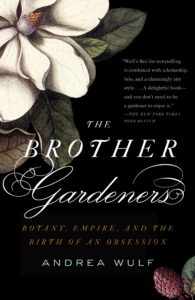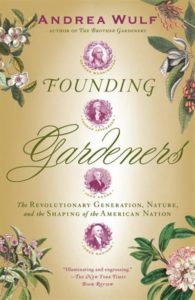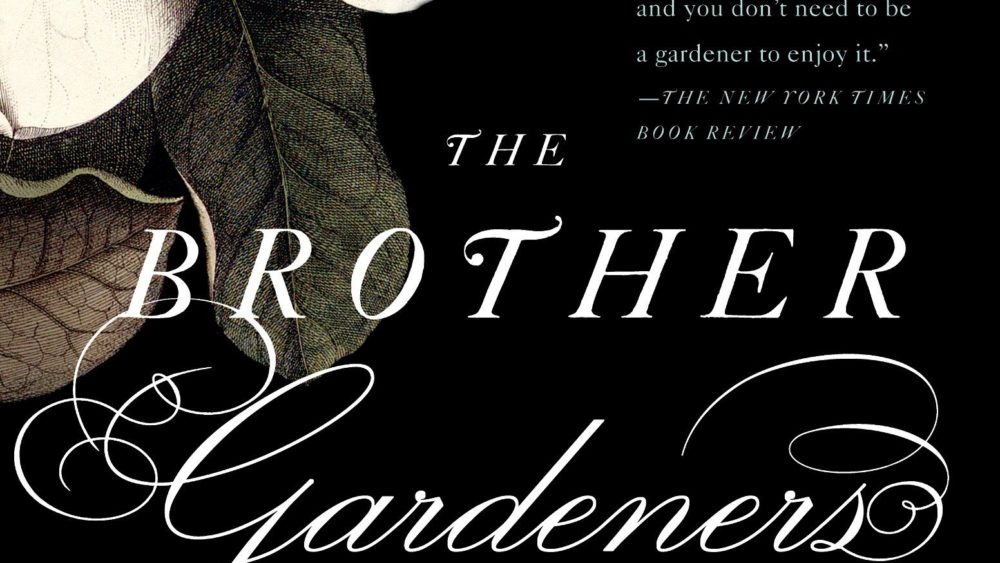The Brother Gardeners: A Generation of Gentlemen Naturalists and the Birth of an Obsession, Vintage Books, 2008, ISBN 9780307454751
Founding Gardeners: The Revolutionary Generation, Nature, and the Shaping of the American Nation, Knopf Doubleday, 2012, ISBN 9780307390684
In these strange and fearful Covid 19 times, when many of us are enduring various degrees of lockdown, either self imposed or induced by public order, there is an opportunity to re-examine the bookshelves, the disorderly piles of forgotten volumes, and hopefully find lost treasure. I certainly did strike lucky last week when I unearthed two companion volumes by Andrea Wulf, read with great pleasure a few years ago, put away, largely forgotten, and now enjoyed afresh all over again.
For anyone who loves plants, for students of taxonomy and etymology, for all of us who enjoy robust characters and strong story telling, these two books are a revelation. Together they tell the true story of the discovery and the naming of hundreds of plants which we know and love today, and of the fascinating cast of characters that contributed to this wealth of knowledge. Along the way we learn about politics and power in the middle to late 1700s America and Britain, about botany and the history of landscape design, about the opening of the Americas and the development of scientific inquiry in Europe, and all this by way of a densely realistic telling of people and their passion for plants.
 The first volume, The Brother Gardeners describes 3 decades of correspondence, enterprise and friendship between an English businessman, Peter Collinson, and an American plant collector and farmer, John Bartram.
The first volume, The Brother Gardeners describes 3 decades of correspondence, enterprise and friendship between an English businessman, Peter Collinson, and an American plant collector and farmer, John Bartram.
Europe and America in the mid 1700s were seething with revolutionary ideas in religion, in politics and in science. One place where this was vividly reflected was in the race to find, classify and name as many plants as possible, and to import exciting novel and new plants from the New World to gardens in Europe.
The first English settlement was Jamestown, Virginia in 1607, and within 100 years a number of plants had been successfully brought over to eager English horticulturalists, including goldenrod, asters, certain lilies and the sycamore and tulip trees. But they were rare specimens and most European botanists and plant lovers knew north American plants only though herbaria and dried specimens. With no agreement on naming and classification, communication among plant people was limited and knowledge of growth habits, needs or diseases was absent. It was these two men, Collinson and Bartram, that are in large part responsible for changing this, and for bringing tens of dozens of plants from north America to England and to our gardens.
Collinson, a cloth and wool merchant in the city of London who traded with others in Pennsylvania, was largely self educated and did not attend university but was never the less elected to the Royal Society in 1728 aged just thirty-four. He never did travel to America or meet John Bartram but for over 30 years they corresponded and did business together and their collaboration changed the look of English gardens.
John Bartram travelled the length and breadth of the east coast of America, sleeping rough, risking life and limb, always seeking new plants. The list of plants Bartram to sent England covers several pages as an epilogue to the book. Many of these were sent as seeds with instructions on germinating, sowing and cultivation. Some, however, were sent in ingenious wooden crates designed by Bartram to keep living plants upright and protected in the long ship crossing.
As these new plants were successfully grown, so they also needed to be named. By the late 1740’s the binomial system of Carl Linnaeus was becoming the scientific standard, even if polite society could not discuss the sexual basis for it.
The book describes some fascinating details about Linneaus, how he was a misogynist, a recluse; how he named plants after people and their characteristics which was fine for Olaf Rudbeckia immortalized in the genus Rudbeckia for his tall stature and radiating brilliance, but unfortunate for his arch enemny, the botanist Siegesbeck, whose name was given to the genus Sigesbeckia which are stinking weeds that thrive in wastelands. Linnaeus named one plant after himself, Linnaeus borealis, and described it as “lowly, insignificant and disregarded” like how he saw himself.
It is these vignettes, these glimpses into the lives and minds of these long-ago plant lovers, that makes these books so fascinating. It may have been 300 years ago but the passions and politics, the science and the spiritual aspects are really not different today.
The Brother Gardeners also describes the deep friendship between Daniel Solander, student of Linnaeus, and Joseph Banks, naturalist and gentleman, and their shared adventures when they sailed with Captain James Cook on the Endeavour to explore the South Pacific ocean and look for new and unknown plants. Subsequently Banks was responsible for convincing King George III to turn the royal gardens at Kew into a world class botanical collection (herbaria specimens and a living collection) and a centre for economic botany.
If The Brother Gardeners is a paean to enduring friendships amongst plant lovers worldwide, then The Founding Gardeners is a rallying cry for the republic, through the medium of land and landscape design.
In 1769 Benjamin Franklin stated in his treatise ‘Positions to be Examined Concerning National Wealth’ that “…there are three ways a nation may acquire wealth: the first is by war which is robbery, the second is by commerce which is generally cheating, and the third is by agriculture which is the only honest way” .
George Washington, John Adams, Thomas Jefferson, James Madison and Benjamin Franklin, the founding fathers who birthed a nation, were all farmers. The first four of these men were the first four presidents, and Franklin was an international diplomat, a visionary and the instigator and architect of the nascent republic. All of them had country properties where they enjoyed bucolic pleasures to counter the thrust and parry of independence politics.
Benjamin Franklin believed that farming represented America’s true wealth and that the nation could be self sufficient and self reliant, not needing to send taxes and remittances back to England that impoverished the settlers. Clearing land, ploughing and planting became political acts, a collective opportunity for defiance and claiming autonomy. America’s endless horizons and fertile soils, the huge trees and rushing rivers, represented immense wealth and immense opportunity to land starved Europeans, escaping overcrowding and grinding poverty. Conquering and inhabiting this vast wilderness became a patriotic act to help the building of the American dream.
 In The Founding Gardeners Andrea Wulf describes the estates of Washington (Mount Vernon), Jefferson (Monticello), Adams (Peacefield) and Madison (Montpelier) and their design and development over time. She goes further, though, and places it all firmly into a political analysis whereby the determination of the founding fathers to go their own way is reflected in the casual design of meadows with woodland pockets and of loose or sinuous forest edges, in contrast to the formal knot gardens, pruned topiary and stiff hedges of English gardens of the times.
In The Founding Gardeners Andrea Wulf describes the estates of Washington (Mount Vernon), Jefferson (Monticello), Adams (Peacefield) and Madison (Montpelier) and their design and development over time. She goes further, though, and places it all firmly into a political analysis whereby the determination of the founding fathers to go their own way is reflected in the casual design of meadows with woodland pockets and of loose or sinuous forest edges, in contrast to the formal knot gardens, pruned topiary and stiff hedges of English gardens of the times.
Washington cared deeply about his land and never stopped thinking about it and scheming to improve it, even when he was on campaign and facing battle. In 1776, as Manhattan braced itself for war, Washington found time to write to write to his estate manager with instructions for planting white pines, tulip trees, dogwood and cedar. He also instructed that no non-native trees should be allowed. A greatly daring initiative was also made by Washington to ensure the troops grew regimental gardens in all camp grounds in order to provide fresh vegetables to the troops.
When he handed in his military commission in 1783 and retired, developing his 8000 acre Mount Vernon estate became Washington’s major occupation. He collected trees and shrubs from all the 13 states and he planted them in natural stands with winding walkways that followed the curves of the land rather than trying to impose order and straight lines on nature. White pines and hemlocks from the north east, live oak and Magnolia grandiflorum from the south, redbud, fringe tree, linden, mountain laurel and sassafras all found a home in his gardens that looked so natural but were meticulously planned.
The other founding fathers were equally assiduous in promoting native plants and the natural design of plantings.
In 1786 Thomas Jefferson and John Adams were in London as emissaries from America and kicking their heels while various trade talks progressed at glacial pace. Deciding to embark on a jaunt to visit grand gardens in the southern part of England, they took a trip the results of which can still be seen in their estates back in America. Jefferson had long been enamoured of the classical English style of gardening and he drew but never executed extensive plans for Monticello to build grottoes and follies, pavilions and pagodas. His summer tour of English gardens changed his mind entirely as it included a very progressive model farm and the pastoral scenes of productive farm lands, rolling meadows and flowery bowers inspired Jefferson to re-create the feeling as best he could when he got back home. The vegetable gardens were beautiful as well as productive and Jefferson was an indefatigable experimenter with selective breeding and seed saving. Indeed, he was in the throes of developing and stocking a botanic garden for the University of Virginia when he died in 1826.
Johns Adams, too, was a plant lover, an avid gardener, and like Jefferson had been inspired by his English sojurn to eschew the formal Continental plantings in favor of natural landscapes and native trees. He is famous for having written, upon seeing a frost and ice rimed winter scene, that “…I have seen the Queen of France with eighteen million livres of diamonds upon her person but all the glitter of her jewels did not make an impression on me equal to that presented by every shrub”. Like Jefferson, he was also involved in establishing a botanic garden, in his case for Harvard University, and he studied Linnaean classification for a hobby.
Madison’s Montpelier estate was more modest than Mount Vernon or Monticello but he, too, planted extensive sweeps of native trees, moved tons of earth to create rolling vistas and formal terraced vegetable and fruit gardens. By the time he became president, the country was stable and prosperous and his garden designs reflect that with more whimsy, decorative buildings and flower beds than previously. Madison also brought his slave quarters up close to the main house where all visitors would see them, instead of keeping them hidden away out of sight as most people did. He struggled all his life with the morality of slave owning and wanted everyone to know he housed them decently and treated them well. In his retirement from politics, Madison became the first president of the Albemarle County Agricultural Society, founded to promote good agricultural practices in the region. In one of his speeches on behalf of the society, he spoke of the importance of cross contour plowing to prevent soil erosion, the value of manure on fields and of adding lime to alkalize a field that had ‘soured’. Madison was also perhaps one of America’s first environmentalists as he spoke often and eloquently of the reciprocity of the natural world where there is always equilibrium and balance, giving as well as taking, like a tree taking nutrients from the soil then dropping it leaves back down. Madison recognized the risk of upsetting this balance and that man must return to the earth as much as he withdrew. He said that the preservation of the environment was essential for survival of mankind and he meant it in a very pragmatic and realistic way, not starry eyed or idealistic. He was concerned about loss of native forest and about people born and raised in cities who did not value nature as those who made their living daily from the land. Some things never change.
The two books can be read individually but taken together they form a strong storyline of the trans Atlantic influences on garden design and on plants and plant names. They demonstrate how a shared love of plants can draw people together and cement a friendship and how plants can influence every aspect of life right up to international politics. Both of these books are filled with fascinating details that bring the characters to life, intriguing snippets about plants and inspiring stories of friendship and power. You won’t learn anything about herbal medicine per se in these books but they will change the way you look at landscapes and gardens and you will come to meet an extraordinary cast of characters that whose hard work and inspiration we continue to enjoy today as we go about our plant work.
Chanchal Cabrera
